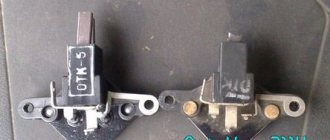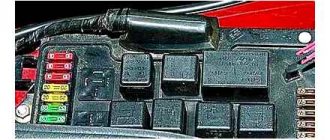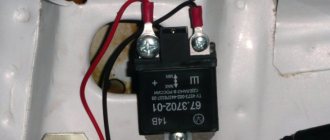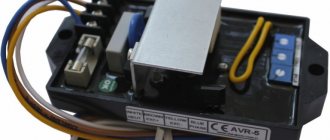The voltage regulator (PH) is a two-stage type PP380, has 2 fixed contacts on the racks 7 and (Fig. 159) and between them a vibrating contact mounted on the armature 10. The contact of the armature with the contacts on the racks forms two pairs of contacts; top and bottom. The armature is constantly pressed against the upper contact by the spring, i.e. The top contacts are normally closed.
When the generator voltage increases to 13.2-14.3 V, the regulator armature begins to vibrate, opening and closing the upper contacts. An additional resistor is switched on and off in the generator excitation winding circuit. This is the 1st stage of regulation.
With a further increase in the generator voltage (with an increase in rotor speed), the lower pair of contacts begins to close and open. This is the 2nd stage of regulation. When the lower contacts are closed, both ends of the field winding are shorted to ground and it is de-energized.
Technical characteristics of the voltage regulator:
- Adjustable voltage at regulator and ambient temperature (50±3)°C, V:
- at the 2nd stage - 14.2±0.3
- at the 1st stage lower than at the second by no more than - 0.7
- Resistance between plug “15” and “ground”, Ohm - 27.7±2
- Resistance between plugs “15” and “67” with open contacts, Ohm - 5.65±0.3
- Air gap between armature and core, mm - 1.4±0.07
- Distance between contacts of the 2nd stage, mm - 0.45±0.1
On the “classic” you can find 2 types of voltage regulator relays: built into the generator and external. The difference lies in the model of the generator that is installed on the car.
On older Zhiguli models (VAZ 2101, 2102, 2103, 2106, 2121 with carburetor engines) a G-221 generator is installed, and the external voltage regulator is a small “box”, which is secured with two nuts on the left mudguard of the body. It is precisely the replacement of such a regulator that will be discussed in this article.
On later VAZ models (2104, 2105 and 2107) there is a G-222 generator, and the voltage regulator is already built into the generator housing and is a small black “tablet”.
Removing and installing the voltage regulator
Replacing the external voltage regulator VAZ 2101-2106
1) Using the “8” socket, unscrew the two nuts and remove the regulator.
2) Disconnect the two wires.
3) Attach the new regulator to the mudguard and connect the wires: orange to terminal “15”, and gray to terminal “67”.
Voltage regulator relay connection diagram
ATTENTION! Before starting the engine, make sure that the contact between the voltage regulator housing and the vehicle ground is reliable, and that the wires to terminals “15” and “67” are connected correctly.
Cost and interchangeability
Built-in relay voltage regulator 71.3702 for generator G-222
The average price for a voltage regulator, both built into the brushes and remote, is about 100 rubles.
Models of generators G-221 and G-222 are interchangeable, that is, you can easily install a new generator from the “seven” for a “penny”, but you should pay attention to the correct charge of the battery. To do this, it is necessary to modify the electrical wiring according to the standard connection diagram.
Depending on the situation, either install an external voltage regulator relay, or, conversely, remove the external one and leave one built into the generator.
The normal voltage in the car's on-board network is considered to be in the range of 13.5-14.5 Volts.
Any car, including the VAZ 2101, has two sources of power supply - a battery and a generator. The generator ensures the operation of all electrical appliances while driving. Its failure can cause a lot of trouble for the car owner. However, diagnosing a malfunction and repairing a VAZ 2101 generator with your own hands is quite simple.
Optimizing device performance
There is an opinion among drivers that tuning the voltage regulator improves the driving performance of the car. First of all, we are talking about large speed ranges without compromising the equipment of the machine. There is some truth in such a statement, because the charging relay is really responsible for correcting all voltage surges at changing speeds. But it will not be possible to significantly increase the indicator.
In addition to replacing the generator, you will need to update the wiring, making it resistant to heavy loads.
Following this, the rotor for charging the VAZ 2106 will require an update. That is why it is recommended to evaluate the financial capabilities and feasibility of such updates.
Voltage drops in the vehicle network are regulated by a special relay. The slightest deviations in its operation negatively affect the running parameters of the machine as a whole. In this regard, drivers are recommended to regularly carry out preventive inspections.
Source
Selecting a generator for VAZ 2101
The manufacturer equipped the VAZ 2101 with generators of the G-221 model. The maximum current of 52 A was enough to operate all standard electrical appliances. However, the installation of additional equipment by car owners (powerful acoustics, navigator, additional headlights, etc.) led to the fact that the G-221 could no longer cope with increased loads. There was a need to replace the generator with a more powerful one.
Without any problems, you can install the following devices on the VAZ 2101:
- A generator from a VAZ 2105 with a maximum current of 55 A. The power is enough to operate a conventional speaker system and, for example, an additional LED strip for lighting. It is installed on standard mounts for the VAZ 2101 generator. The only differences are that the regulator relay is built into the generator housing, while on the G-221 it is located separately.
- Generator from VAZ 2106 with a maximum current of 55 A. Withstands slight overloads. Installed on standard G-221 mounts.
- Generator from VAZ 21074 with a maximum current of 73 A. Its power is sufficient to operate any additional electrical equipment. It is installed on standard VAZ 2101 mounts, but the connection diagram is slightly different.
- Generator from VAZ 2121 Niva with a maximum current of 80 A. The most powerful among its analogues. However, its installation on the VAZ 2101 will require significant modifications.
- Generators from foreign cars. The best option is generators from Fiat. Installing such a device on a VAZ 2101 will require noticeable changes in the design of the generator mounting and its connection diagram without guarantees of high-quality operation.
Photo gallery: generators for VAZ 2101
In fact, it will be enough for the driver of a VAZ 2101 to install a generator from a “six” or “seven” to satisfy all his electricity needs. Even with complex tuning, a power of 60–70 amperes is enough to maintain the operation of all devices.
Electronic warning lamp relays.
Also, in addition to electromagnetic relays, electronic relays. Of course, these relays are much more reliable. They were widely used in foreign cars produced in the 80s. The principle of these relays is to control the voltage of the on-board network. If the voltage is less than the nominal value, then the control lamp is turned on using an electromagnetic relay or a built-in transistor. On domestic cars, this principle is found on Nivas with a carburetor engine and an imported instrument panel, as well as on other models with imported instrument panels. As a control lamp, such panels used an LED, which was controlled by a unit built into the panel. Such cars were produced in a limited edition.
admin 20/11/2013
“If you notice an error in the text, please highlight this place with the mouse and press CTRL+ENTER” “If the article was useful to you, share the link to it on social networks”
Connection diagram for the VAZ 2101 generator
The VAZ 2101 generator is connected using a single-wire circuit - one wire from the generator is connected to each device. This makes it easy to connect the generator yourself.
Features of connecting the VAZ 2101 generator
Several multi-colored wires are connected to the VAZ 2101 generator:
- the yellow wire comes from the warning light on the dashboard;
- a thick gray wire goes from the regulator relay to the brushes;
- a thin gray wire goes to the relay;
- The orange wire acts as an additional connector and is usually connected to a thin gray wire during installation.
Incorrect connection of wires can cause a short circuit or voltage surges in the electrical circuit of the VAZ 2101.
Physical characteristics of operating parameters
The original VAZ 2101 generator maintains the specified parameter at 13 to 14 V. This device is used only over a wide range of vehicle rotor speeds. As an additional line of defense for electricity consumers 2106 or 01, a non-contact type voltage level regulator is used - 121.3702. If necessary, it will replace the RV-380, and the VAZ charging circuit will not be affected.
An additional fuse keeps the voltage between 13.5 and 14.6 V over a wide rotor rotation range. The remaining technical specifications are as follows:
- operating temperature range: from -40 to +80°C;
- Additional resistor resistance: 5.5 Ohm (25 W);
- resistor with thermal compensation function: 19 Ohm (6 W);
- voltage regulation at stage I: 0.7 V;
- voltage regulation at stage II: from 14.2 to 14.5 V.
According to the structure, voltage regulation of the VAZ 2101 is carried out using a variable magnetic field. In the event of a technical malfunction, it is necessary to carry out diagnostics and replacement, if necessary. Experienced drivers do not recommend operating a car if the VAZ 2106 generator does not balance voltage surges.
The device of the VAZ 2101 generator
For its time, the design of the G-221 generator turned out to be quite successful. It was installed without modifications on subsequent models of the plant - VAZ 2102 and VAZ 2103. With proper maintenance and timely replacement of failed elements, it could be used for many years.
Structurally, the G-221 generator consists of the following main elements:
- rotor;
- stator;
- regulator relay;
- semiconductor bridge;
- brushes;
- pulley.
The G-221 generator is attached to the engine on a special bracket. This allows you to firmly fix the device and at the same time protect it from high temperatures.
Rotor
The rotor is the moving part of the generator. It consists of a shaft, onto the corrugated surface of which a steel sleeve and beak-shaped poles are pressed. This design serves as the core of an electromagnet rotating in two ball bearings. Bearings must be closed type. Otherwise, due to lack of lubrication, they will quickly fail.
The pulley can be considered either part of the generator or a separate element. It is installed on the rotor shaft and can be easily removed if necessary. When the engine is running, the pulley rotates by the crankshaft through the belt and transmits torque to the rotor. To prevent the pulley from overheating, there are special blades on its surface that provide natural ventilation.
Stator with windings
The stator consists of a number of special plates made of electrical steel. To increase resistance to loads in four places on the outer surface, these plates are connected by welding. A winding of copper wire is laid on them in special grooves. In total, the stator contains three windings, each of which consists of two coils. Thus, six coils are used to generate electricity by the generator.
Regulator relay
The regulator relay is a small plate with an electrical circuit inside, designed to control the voltage at the output of the generator. On the VAZ 2101, the relay is located outside the generator and is mounted on the rear cover from the outside.
Purpose of the regulator relay VAZ 2107 injector and carburetor
The main purpose of the voltage regulator relay on the VAZ 2107, and any other car, is to maintain a stable and sufficient charging current for the on-board network and the car battery, as well as to level out voltage surges in the generator. Variations in the generated voltage would occur as the generator rotates at different frequencies. When the power drops below 12V, the battery stops charging, and the entire bot network no longer functions at 100%. If the voltage exceeds 16 Volts, this can lead to boiling of the battery, as well as failure of on-board devices.
On early production VAZ cars of the carburetor type, the voltage regulator is located on the left arch of the engine compartment. Such devices are also called external, since they were installed outside the generator structure. To be more precise, a brush mechanism was installed in the generator, and control was carried out via a printed circuit board, which was installed outside the product.
Most VAZ 2107 cars of the carburetor and injection type are equipped with generators with built-in charging relays. The charging relay on such VAZ 2107 vehicles is located directly on the side of the generator opposite the pulley.
To maintain an acceptable battery charge, the alternator requires 13.6 to 14.6 volts of power. The voltage regulation circuit is carried out using an electrical circuit, which is located on a printed circuit board (chocolate board) or in the form of a single semiconductor module (tablet) with brushes. The switch located inside the generator is usually not able to adequately respond to the ambient temperature due to its location close to the running engine. The built-in relay is sometimes replaced with a three-level voltage regulator, which is due to the greater efficiency of the product due to manual adjustment of the output voltage.
How to check the charging relay on a VAZ 2107
If you suspect a faulty operation of the voltage regulator relay, then you must first check the voltage at the battery terminals with the car running. The power supply must be no lower than 13 and no higher than 14.6 Volts. The reasons for such increased or decreased voltage can be caused by the following factors:
- charging regulator malfunction;
- failure of the generator itself;
- lack of contact in the electrical connections of the battery or generator.
To check the serviceability of the chocolate bar, it is necessary to remove it from the generator. This must be done by unscrewing two bolts.
It is important to know! Before you begin to remove the device, do not forget to remove the negative terminal from the battery.
To check the serviceability of the product, you need to connect a voltmeter or test lamp, as well as an adjustable power source of 12-22 Volts. You can use a power supply with a variable resistor. The control check of the regulator relay is carried out by connecting the minus wire from the regulated source to ground or terminal “Ш”. The positive wire of the power supply must be connected to terminal “B”. A voltmeter or lamp is connected to the brushes or relay output. If the product is in good working order, then when a voltage of 12 to 14 Volts is applied to it, the light will light up or the voltmeter will show similar values. If you apply power above 16 Volts, the light should go out. If the light bulb is constantly glowing, you can judge that the product is broken. The absence of a light bulb indicates a break in the relay. In both cases, the regulator cannot be repaired, so it needs to be replaced.
Diagnostics and troubleshooting of the VAZ 2101 generator
There are a number of signs and signals by which you can determine that the generator is faulty.
The charging indicator light comes on
On the dashboard of the VAZ 2101 there is a battery charging indicator. It lights up if the battery charge is close to zero. This usually happens when the generator is faulty, when electrical appliances are powered from the battery. Most often the light comes on for the following reasons:
- Slipping of the V-belt on the generator pulley. It is recommended to check the belt tension, and if there is severe wear, replace it with a new one.
- Failure of the battery charging indicator relay. You should check the serviceability of the relay using a multimeter.
- Break in the stator winding. It is necessary to disassemble the generator and clean all its elements.
- Severe brush wear. All brushes in the holder will need to be replaced, even if only one of them is worn out.
- Short circuit in the diode bridge circuit. The burned out diode or the entire bridge should be replaced.
Battery won't charge
One of the tasks of the generator is to recharge the battery while driving. If this does not happen, you should pay attention to the following points.
- Sagging V-belt. It is necessary to adjust its tension or replace it.
- Loosening of the wire ends connecting the generator to the battery. All contacts should be cleaned or damaged tips should be replaced.
- Battery failure. This can be checked and fixed by installing a new battery.
- Damage to the voltage regulator. It is recommended to clean all contacts of the regulator and check the integrity of the wires.
The battery is boiling over
If the battery begins to boil away, then, as a rule, its service life is coming to an end. In order not to risk the new battery, it is recommended to accurately identify the cause of boiling. It could be:
- Lack of permanent contact between the generator voltage regulator housing and ground. It is recommended to clean the contacts and replace them if necessary.
- Short circuit in the regulator. The voltage regulator needs to be replaced.
- Battery failure. A new battery must be installed.
Loud noise while driving
The VAZ 2101 generator usually operates quite noisily. The cause of the noise is the presence of contacting and rubbing elements in the generator design. If this noise has become unusually loud, knocking, whistling and rumbles have appeared, it is necessary to identify the cause of this situation. This is usually due to the following problems.
- Loosening the fixing nut on the generator pulley. Tighten the nut and check all fastener joints.
- Bearing failure. You will need to disassemble the generator and replace the bearings.
- Short circuit in the stator winding. The stator assembly needs to be replaced.
- Brushes creaking. It is recommended to clean the contacts and brush surfaces.
Correct repair and replacement of the device
Maintenance is carried out in a garage, even if the driver does not have much experience in car mechanics. First you need to turn off the engine and remove the terminals from the battery. Further repairs involve carefully removing the two nuts of the regulator itself using an “8” wrench. As soon as the device comes out of the grooves, you must smoothly disconnect the 2 wires.
It is recommended to inspect the generator pulley and its housing for signs of mechanical damage or short circuit. If there are any, then there is no point in repairing it. Firstly, it will take a lot of time, and secondly, the battery charging process will not be complete. In this case, it is more advisable to purchase a new regulator.
It is attached to the mudguard and secured with 2 bolts. The following recommendation will help you correctly connect the generator to the VAZ: the orange wire is connected to output No. 15, and the gray wire to output 67. The VAZ 2106 generator connection diagram, which should be at hand, will help you avoid getting confused here. You must use the option supplied with your passport. He will tell you in detail how to connect the generator.
Before turning the key in the ignition switch, it is imperative to make sure that the contact between ground and housing 2101 is reliable. If this is not done, the service life of voltage regulator 2101 will be short-lived. Excessive charge will literally burn the device.
Analogues or original spare parts? There is no consensus among drivers about which parts are best to use. The cost of a new voltage device is about 100 rubles, and connecting the generator itself does not require professional skills. Despite this, it is better not to take risks, because uncompensated power surges will damage all the electronics in the car.
Checking the functionality of the VAZ 2101 generator
The generator going out and breaking down is a rather unpleasant situation. Experts recommend periodically (at least twice a year) assessing its performance to determine the remaining resource.
You cannot check the functionality of the generator on a VAZ 2101 when disconnected from the battery while the engine is running, since there is a high probability of a voltage surge.
This can be done either at a stand in a service station or using an oscilloscope. However, no less accurate results can be obtained in a garage using a conventional multimeter.
Checking the generator with a multimeter
To test the generator, you can use either an analog or digital multimeter.
The specificity of the test does not allow the work to be carried out alone. Therefore, it is necessary to invite a friend in advance, since one person will have to be in the cabin, and the other will have to monitor the readings of the multimeter in the engine compartment of the car.
The verification algorithm is extremely simple and consists of performing the following steps.
- The multimeter is set to DC current measurement mode.
- The device is connected to the battery terminals. With the engine not running, it should show between 11.9 and 12.6 V.
- The interior assistant starts the engine and leaves it idling.
- When the engine starts, the multimeter readings are recorded. If the voltage drops sharply, the generator's life is insignificant. If the voltage, on the contrary, jumps (to about 14.5 V), then the excess charge will lead to the battery boiling in the near future.
Video: checking the VAZ 2101 generator
The norm is a small voltage drop when the engine starts and a quick recovery of performance characteristics.
Worth checking out:
Next, the generator is assembled in the reverse order. The rotor is reinstalled using hammer blows
At the very end of assembly it is important to lock the bolts
Recommendation: if the capacitor seating surface is sanded, the contact will improve and become more stable.
Car owners who have an outdated version of the diode bridge installed may encounter difficulties with the output of pin 61, because it is difficult to fit into the hole on the back cover. One way to solve the problem is to enlarge the hole with a file.
After all the above steps have been completed, the repair of the VAZ 2101 generator can be considered complete. Next, you need to install it on the vehicle and test it in action.
Alternator belt VAZ 2101
In classic VAZ models, the generator is driven by a V-belt 944 mm long. On a VAZ 2101 you can also install a belt with a length of 930 mm, but other options are no longer suitable.
The factory equipment of the generator involves the use of a belt 2101–1308020 with a smooth surface and dimensions 10x8x944 mm.
The alternator belt is located in the front of the car and connects three pulleys at once:
- generator pulley;
- water pump pulley;
- crankshaft pulley.
How to properly tension the alternator belt
When replacing the alternator belt, it is extremely important to tension it correctly. Any deviation from the norm will affect the operation of VAZ 2101 electrical appliances.
Reasons for replacing the alternator belt are:
- the appearance of cracks and signs of severe wear on the belt;
- belt break;
- manufacturing defects.
To replace the belt you will need:
- mounting spatula (or metal crowbar);
- wrenches 17 and 19.
The work is performed in the following order:
- Reinstall the generator by tightening the two mounting nuts halfway. The nuts must be tightened until the stroke of the generator housing exceeds 2 cm.
- Insert a pry bar or pry bar between the generator housing and the water pump housing.
- Place the belt on the pulleys.
- Without releasing pressure from the pry bar, tighten the strap.
- Tighten the top nut securing the generator.
- Check the belt tension. It should not be too tight or, conversely, sagging.
- Tighten the bottom nut.
Video: tensioning the VAZ 2101 alternator belt
To make sure that the belt has a working degree of tension, it is necessary to sell its free space with your finger after completing the work. The rubber should yield no more than 1.5 centimeters.
Thus, even an inexperienced car enthusiast can independently diagnose the malfunction, repair and replace the VAZ 2101 generator. This does not require any special skills or exclusive tools. However, you should not overestimate your strength either. It must be remembered that a generator is an electrical device, and in the event of an error, the consequences for the machine can be quite serious.
Replacing the unit
It is not difficult to remove the generator from the classic Zhiguli model. But it is mounted at the bottom of the engine compartment, under the engine, and must be removed from below. This means that you will need an inspection hole or overpass. The preparatory operation consists of placing the car in a pit and removing the engine crankcase protection, if any. It is also necessary to open the hood and remove the negative ground terminal of the battery. Now everything is ready for removal.
The work is performed in the following order. Disconnect the generator of your VAZ 2101 from the vehicle's electrical system. Unscrew the nut securing the positive wires to the generator. Disconnect the brush connector and the diode bridge connector.
Unscrew the nut securing the unit to the adjustment bar a couple of turns. If possible, use a socket head and an extension with a universal joint. Tilt the generator so that the belt sags on the pulleys of the crankshaft, water pump and VAZ 2101 generator. Remove the belt.
Go down into the pit. Using a 19 mm wrench, unscrew the large fastening nut. The bolt that secures the unit is located at the very bottom of the engine compartment and is exposed to wind and water, snow and dirt, so it often sticks. Knock it out with a hammer. Carefully remove the generator from the VAZ 2101.
If repairs are expected, proceed to it. Replacement is planned - mount the generator on your VAZ 2101 in the reverse order. To connect, connect the plugs and tighten the nut securing the wires.











